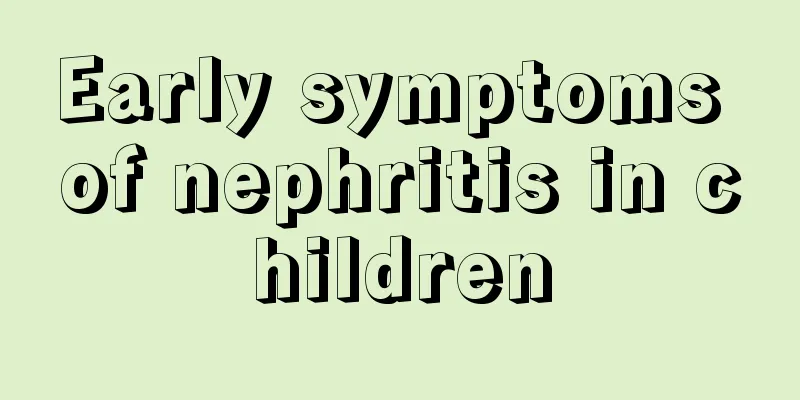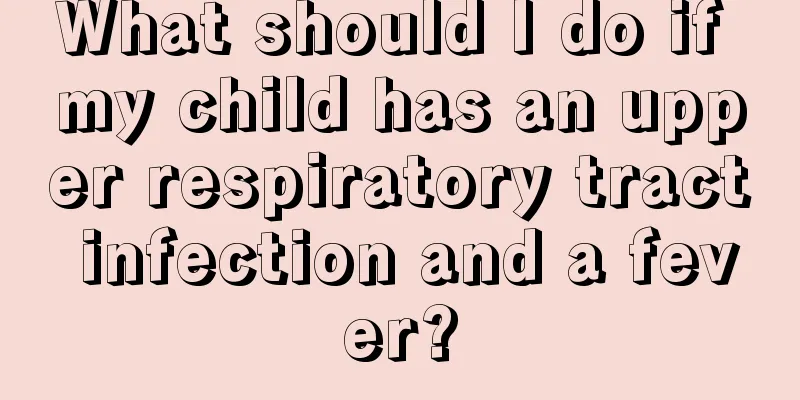Early symptoms of nephritis in children

|
Children are more susceptible to diseases because their organs are not fully developed, so we must take good care of them. Once a child becomes ill, we cannot use medication indiscriminately. We must consult a doctor before using medication. We should also understand the symptoms of some common childhood diseases, which will help us make accurate judgments when the disease occurs. Pediatric nephritis is a disease that can cause great harm to children's bodies. We need to understand the symptoms of pediatric nephritis, especially the early symptoms of pediatric nephritis, which will help prevent the disease from worsening. There are often precursor infections such as acute tonsillitis and skin pustulosis 1-4 weeks before the onset of the disease. Symptoms initially include low fever, dizziness, nausea, vomiting, loss of appetite, etc. These symptoms are no different from general fever infection, are not likely to attract people's attention, and are often ignored. Edema and oliguria are the characteristics of this disease. Generally, the edema starts from the child's eyelids and gradually spreads to the whole body. There is no depression when pressing with fingers. When edema occurs, the urine volume is significantly reduced or even absent. Within about 1-2 weeks, the urine volume gradually increases and the edema gradually subsides. In most children, hematuria is invisible to the naked eye, and only a small number of children have visible hematuria. The color of hematuria can be bright red like meat washing water or dark tea color. This is related to the acidity and alkalinity of urine. I hope you will pay attention to this when observing the urine of children. Generally, this visible hematuria disappears within 1-2 weeks. Children with hypertension experience nausea, vomiting, and dizziness, but if blood pressure rises too quickly, many serious complications may occur. Currently, medical and health conditions in Chinese cities have been greatly improved. Acute nephritis can be treated promptly when it occurs, so serious cases are rare in cities, but they still occur in remote rural areas. If these serious diseases are not discovered early and treated in time, they can lead to the death of the child. In the early stage of the disease, the child's urine volume decreases significantly, edema worsens, breathing becomes rapid, heart rate increases, and irritability occurs. Then the condition may deteriorate rapidly, with difficulty breathing, inability to lie flat, pale complexion, cold limbs, frequent coughing, and pink foamy sputum, indicating that the child has heart failure. If the child experiences severe dizziness, nausea, vomiting, and transient blindness in the early stages of the disease, or in severe cases, sudden convulsions and coma, these are manifestations of hypertensive encephalopathy. Some severe cases develop acute renal failure in the early stages. If the above situations are not dealt with in time, the consequences will be disastrous. If a child has a history of tonsillitis or purulent skin infection and also has edema and oliguria, he or she should be diagnosed and treated as soon as possible. It is more common in children aged 3-8 years old, and extremely rare in children under 2 years old. It is an acute onset disease. It often occurs 1-4 weeks after a precursor infection such as upper respiratory tract infection, skin infection, scarlet fever, and the course of the disease is less than 1 year. The clinical manifestations vary in severity. Mild cases only have microscopic hematuria, a small amount of proteinuria and mild eyelid edema, or no obvious clinical symptoms. Typical: acute onset, with symptoms such as oliguria, edema, hematuria and hypertension. Severe cases: heart failure, acute renal failure, hypertensive encephalopathy, headache, vomiting, coma, etc. may occur in a short period of time. Laboratory examination: Urinalysis shows hematuria and proteinuria, granular casts may also be seen, antistreptolysin "O" or antistreptokinase, antihyaluronidase are elevated, serum total complement and C3 are decreased, and usually return to normal within 4-6 weeks. Fibrin degradation products (FDP) may be positive, endogenous creatinine clearance is reduced, and blood urea nitrogen is elevated. Others: In some cases, chest X-ray showed a general enlargement of the heart, electrocardiogram showed T wave changes, and renal scan showed varying degrees of renal impairment. In the above article, we introduced that children's organs are not fully developed, so we must take good care of children. Children should not be given medicines indiscriminately when they are sick. They should be given medicines only after consulting a doctor. The pediatric nephritis mentioned above causes great harm to children's bodies. We introduced the early symptoms of pediatric nephritis. Once the early symptoms of pediatric nephritis appear, we must seek timely treatment. |
<<: The benefits of eating cauliflower for children
>>: Can children eat Wuchang fish?
Recommend
Motor development delay
The development of a baby's motor function is...
What is the difference between bacterial and viral infections in children?
In today's life, children's diseases are ...
What causes urticaria in babies?
Urticaria is a very common skin disease and also ...
3 year old baby crying at night
It is normal for babies to cry, and there are man...
Baby's whole body is hot and his hands and feet are hot
For many babies, because they cannot fully expres...
What to do if newborn baby has high jaundice
Newborn babies' immune systems are not fully ...
What foods are good for babies' eyes?
Eyes are the most important organs of the human b...
What to do if you have cerebral palsy and drool
Drooling is a relatively common symptom of cerebr...
Two-year-old baby walks on tiptoe
Two-year-old babies have learned to walk for more...
What to do if your child has a fever
Because children's resistance is poor, they a...
What anti-inflammatory drugs can be used for a 32-month-old baby's cough?
Cough is one of the common symptoms among people....
How to regulate the stomach of a one-month-old baby
The stomach of newborn babies is very bad because...
Ten tips to help you solve the problem of children's picky eating
Now many children in our family have more or less...
Correct way to massage for indigestion in children
Children at home are treasures. Do you know the c...
What to do if your baby has chapped lips
Due to the windy and dry weather in autumn and wi...









